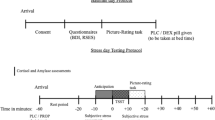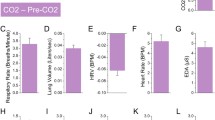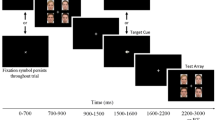Abstract
Rationale
Research in rodents and non-human primates implicates the noradrenergic system and hypothalamic–pituitary–adrenal axis in stress, anxiety, and attention to threat. Few studies examine how these two neurochemical systems interact to influence anxiety and attention in humans.
Objective
The objective of this paper is to examine the effects of exogenous yohimbine and hydrocortisone, as well as their combination (Y + H), on panic symptoms and attention to social threat cues.
Methods
Thirty-two healthy adults underwent a pharmacological challenge in which they were blindly randomized to either yohimbine, hydrocortisone, Y + H, or placebo. Thirty minutes after drug infusion, attention to threat was measured using the dot probe task, a visual attention task that presents angry, happy, and neutral faces and measures the degree of attention allocated towards or away from the emotional faces. Panic and autonomic measures were assessed before and 30 min after drug infusion.
Results
There was a significant increase in panic symptoms in the yohimbine and Y + H groups, but not in the hydrocortisone or placebo groups. Yohimbine resulted in a greater increase in panic symptoms than Y + H. On the dot probe task, the placebo group exhibited an attention bias to angry faces, whereas this bias was absent after yohimbine. When collapsing across groups, increased panic symptoms was associated with less attention to angry faces.
Conclusions
Exogenous hydrocortisone may attenuate noradrenergic-induced panic symptoms. The inverse relationship between panic symptoms and attention to angry faces extends prior research demonstrating attention modulation by stressful conditions.





Similar content being viewed by others
References
Amir N, McNally RJ, Riemann BC, Burns J, Lorenz M, Mullen J (1996) Suppression of the emotional Stroop effect by increased anxiety in patients with social phobia. Behav Res Ther 11:945–948
Aston-Jones G, Rajkowski J, Kubiak P, Alexinsky T (1994) Locus coeruleus neurons in monkey are selectively activated by attended cues in a vigilance task. J Neurosci 14:4467–4480
Bar-Haim Y, Lamy D, Pergamin L, Bakermans-Kranenburg MJ, van Ijzendoorn MH (2007) Threat-related attentional bias in anxious and nonanxious individuals: a meta-analytic study. Psychol Bull 33:1–24
Berridge CW, Waterhouse BD (2003) The locus coeruleus-noradrenergic system: modulation of behavioral state and state-dependent cognitive processes. Brain Res Brain Res Rev 42:33–84
Bradley BP, Mogg K, Falla SJ, Hamilton LR (1998) Attentional bias for threatening facial expression in anxiety: manipulation of stimulus duration. Cogn Emot 12:737–753
Bradley BP, Mogg K, White J, Groom C, de Bono J (1999) Attentional bias for emotional faces in generalized anxiety disorder. Br J Clin Psychol 38:267–278
Bradley BP, Mogg K, Millar N (2000) Covert and overt orienting of attention to emotional faces in anxiety. Cogn Emot 14:789–808
Brown LL, Tomarken AJ, Orth DN, Loosen PT, Kalin NH, Davidson RJ (1996) Individual differences in repressive-defensiveness predict basal salivary cortisol levels. J Pers Soc Psychol 70:362–371
Buchanan TW, Brechtel A, Sollers JJ, Lovallo WR (2001) Exogenous cortisol effects on the startle reflex independent of emotional modulation. Pharmacol Biochem Behav 68:203–210
Byrne A, Eysenck MW (1995) Trait anxiety, anxious mood and threat detection. Cogn Emot 9:549–562
Charney DS, Heninger GR (1986) Abnormal regulation of noradrenergic function in panic disorder: effects of clonidine in healthy subjects and patients with agoraphobia and panic disorder. Arch Gen Psychiatry 43:1042–1055
Charney DS, Heninger GR, Sternberg DE (1982) Assessment of α2 adrenergic autoreceptor function in humans: effects of oral yohimbine. Life Sci 30:2033–2041
Charney DS, Heninger GR, Breier A (1984) Noradrenergic function in panic anxiety. Effects of yohimbine in healthy subjects and patients with agoraphobia and panic disorder. Arch Gen Psychiatry 41:751–763
Charney DS, Woods SW, Goodwin WK, Heninger GR (1987) Serotonin function in anxiety II. Effects of the serotonin agonist MCPP in panic disorder patients and healthy subjects. Psychopharmacology 92:14–24
Charney DS, Woods SW, Krystal JH (1992) Noradrenergic neuronal dysregulation in panic disorder: the effects of intravenous yohimbine and clonidine in panic disorder. Acta Psychiatrica Scand 86:273–282
Chen YP, Ehlers A, Clark DM, Mansell W (2002) Patients with generalized social phobia direct their attention away from faces. Behav Res Ther 420:677–687
Chrousos GP, Harris AG (1998) Hypothalamic–pituitary–adrenal axis suppression and inhaled corticosteroid therapy. Neuroimmunomodulation 5:277–287
Constans JI, McCloskey MS, Vasterling JJ, Brailey K, Mathews A (2004) Suppression of attentional bias in PTSD. J Abnor Psychol 113:315–323
Coplan JD, Pine D, Papp L, Martinez J, Cooper T, Rosenblum LA, Gorman JM (1995) Uncoupling of the noradrenergic–hypothalamic–pituitary–adrenal axis in panic disorder patients. Neuropsychopharmacology 13:65–73
Coplan JD, Papp LA, Pine D, Martinez J, Cooper T, Rosenblum LA, Klein DF, Gorman JM (1997) Clinical improvement with fluoxentine therapy and noradrenergic function in patients with panic disorder. Arch Gen Psychiatry 54:643–648
Coull JT, Nobre AC, Frith CD (2001) The noradrenergic alpha-2 agonist clonidine modulates behavioural and neuroanatomical correlates of human attentional orienting and alerting. Cereb Cortex 11:73–84
de Leon MJ, McRae T, Rusinek H, Convit A, De Santi S, Tarshish C, Golomb J, Volkow N, Daisley K, Orentreich N, McEwen B (1997) Cortisol reduces hippocampal glucose metabolism in normal elderly, but not in Alzheimer's disease. J Clin Endocrinol Metab 82(10):3251–3259
DeBattista C, Posener JA, Kalehzan BM, Schatzberg AF (2000) Acute antidepressant effects of intravenous hydrocortisone and CRH in depressed patients: a double-blind, placebo-controlled study. Am J Psychiatry 157:1334–1337
Derendorf H, Mollmann H, Barth J, Mollmann C, Tunn S, Krieg M (1991) Pharmacokinetics and oral bioavailability of hydrocortisone. J Clin Pharmacol 31:473–476
Dunn AJ, Swiergiel AH, Palamarchouk V (2004) Brain circuits involved in corticotropin-releasing factor–norepinephrine interactions during stress. Ann N Y Acad Sci 1018:25–34
Fox E, Russo R, Bowles R, Dutton K (2001) Do visual stimuli draw or hold attention in subclinical anxiety? J Exp Psychol Gen 130(4):681–700
Goldstein DS, Grossman E, Listwak S, Folio CJ (1991) Sympathetic reactivity during a yohimbine challenge test in essential hypertension. Hypertension 18:40–48
Goodwin GM, Muir WJ, Seckl JR, Bennie J, Carroll S, Dick H, Fink G (1992) The effects of cortisol infusion upon hormone secretion from the anterior pituitary and subjective mood in depressive illness and in controls. J Affect Disord 26:73–83
Gray JA (1982) The neuropsychology of anxiety: an enquiry into the functions of the septo-hippocampal system. Oxford University Press, Oxford
Helfinstein SM, White LK, Bar-Haim Y, Fox NA (2008) Affective primes suppress attention bias to threat in socially-anxious individuals. Behav Res Ther 46:799–810
Kagan J, Reznick JS, Snidman N (1987) The physiology and psychology of behavioral inhibition in children. Child Dev 58:1459–1473
Kaufman AS, Kaufman NL (1990) Kaufman brief intelligence manual. American Guidance Service, Circle Pines, MN
Kolassa IT, Eckart C, Ruf M, Neuner F, de Quervain DJ, Elbert T (2007) Lack of cortisol response in patients with posttraumatic stress disorder (PTSD) undergoing a diagnostic interview. BMC Psychiatry 7:54
Koob GF (1999) Corticotropic-releasing factor, norepinephrine and stress. Biol Psychiatry 46:1167–1180
Laaris N, Le Poul E, Laporte A, Hamon M, Lanfumey L (1999) Differential effects of stress on presynaptic and postsynaptic 5-hydroxytryptamine-1A receptors in the rat brain: an in vitro electrophysiological study. Neuroscience 91:947–958
Liddell BJ, Brown KJ, Kemp AH, Barton MJ, Das P, Peduto A, Gordon E, Williams LM (2005) A direct brainstem–amygdala–cortical 'alarm' system for subliminal signals of fear. Neuroimage 24:235–243
MacLeod C, Mathews A (1988) Anxiety and the allocation of attention to threat. Q J Exp Psychol A 38:659–670
MacLeod C, Rutherford EM (1992) Anxiety and the selective processing of emotional information: mediating roles of awareness, trait and state variables, and personal relevance of stimulus materials. Behav Res Ther 30:479–491
Makino S, Hashimoto K, Gold PW (2002) Multiple feedback mechanisms activating corticotropin releasing hormone system in the brain during stress. Pharmacol Biochem Behav 73:147–158
Mansell W, Clark D, Ehlers A, Cheny Y (1999) Social anxiety and attention away from emotional faces. Cogn Emot 13:673–690
Mansell W, Clark D, Ehlers A (2003) Internal versus external attention in social anxiety: an investigation using a novel paradigm. Behav Res Ther 41:555–572
Markovitz JH, Matthews KA, Wing RR, Kuller LH, Meilahn EN (1991) Psychological, biological and health behaviour predictors of blood pressure changes in middle-aged women. J Hypertens 9:399–406
Mathew SJ, Price RB, Charney DS (2008) Recent advances in the neurobiology of anxiety disorders: implications for novel therapeutics. Am J Med Genet C Semin Med Genet 148:89–98
Mathews A, Sebastian S (1993) Suppression of emotional Stroop effects by fear-arousal. Cogn Emot 7:517–530
McNaughton N, Corr PJ (2004) A two-dimensional neuropsychology of defense: fear/anxiety and defensive distance. Neurosci Biobehav Rev 28:285–305
Mogg K, Bradley BP (1999) Some methodological issues in assessing attentional biases for threatening faces in anxiety: a replication study using a modified version of the probe detection task. Behav Res Ther 37:595–604
Mogg K, Bradley BP (2005) Attentional bias in generalized anxiety disorder versus depressive disorder. Cognit Ther Res 29:29–45
Mogg K, Mathews A, Bird C, Macgregor-Morris R (1990) Effects of stress and anxiety on the processing of threat stimuli. J Pers Soc Psychol 59:1230–1237
Mogg K, Kentish J, Bradley BP (1993) Effects of anxiety and awareness of colour-identification latencies for emotional words. Behav Res Ther 31:559–567
Mogg K, Bradley BP, Hallowell N (1994) Attentional bias to threat: roles of trait anxiety, stressful events, and awareness. Q J Exp Psychol A 47:841–864
Mogg K, Philippot P, Bradley BP (2004) Selective attention to angry faces in clinical social phobia. J Abnorm Psychol 113:160–165
Monk CS, Nelson EE (2002) The effects of hydrocortisone on cognitive and neural function: a behavioural and event-related potential investigation. Neuropsychopharmacology 26(4):505–519
Monk CS, Nelson EE, McClure EB, Mogg K, Bradley BP, Leibenluft E, Blair RJ, Chen G, Charney DS, Ernst M, Pine DS (2006) Ventrolateral prefrontal cortex activation and attentional bias in response to angry faces in adolescents with generalized anxiety disorder. Am J Psychiatry 163:1091–1097
Moran J, Desimone R (1985) Selective attention gates visual processing in the extrastriate cortex. Science 229:782–784
Nay WT, Thorpe GL, Roberson-Nay R, Hecker JE, Sigmon ST (2004) Attentional bias to threat and emotional response to biological challenge. J Anxiety Disord 18:609–627
Nunnally JC, Bernstein IH (1994) Psychometric theory, 3rd edn. McGraw-Hill Pine, New York, NY
Pine DS, Mogg K, Bradley BP, Montgomery L, Monk CS, McClure E, Guyer AE, Ernst M, Charney DS, Kaufman J (2005) Attention bias to threat in maltreated children: implications for vulnerability to stress-related psychopathology. Am J Psychiatry 162:291–296
Powell SB, Palomo J, Carasso BS, Bakshi VP, Geyer MA (2005) Yohimbine disrupts prepulse inhibition in rats via action at 5-HT1A receptors, not alpha2-adrenoceptors. Psychopharmacology 180:491–500
Putman P, Hermans EJ, Koppeschaar H, van Schijndel A, van Honk J (2007) A single administration of cortisol acutely reduces preconscious attention for fear in anxious young men. Psychoendocrinology 32:793–802
Rasmusson AM, Hauger RL, Morgan CA, Bremner JD, Charney DS, Southwick SM (2000) Low baseline and yohimbine-stimulated plasma neuropeptide Y (NPY) levels in combat-related PTSD. Biol Psychiatry 47:526–539
Rasmusson AM, Lipschitz DS, Wang S, Hu S, Vojvoda D, Bremner JD, Southwick SM, Charney DS (2001) Increased pituitary and adrenal reactivity in premenopausal women with posttraumatic stress disorder. Biol Psychiatry 50:965–977
Redmond DE Jr (1987) The possible role of locus coeruleus noradrenergic activity in anxiety–panic. Clin Neuropharmacol 9(Suppl 4):40–42
Roelofs K, Bakvis P, Hermans EJ, van Pelt J, van Honk J (2007) The effects of social stress and cortisol responses on the preconscious selective attention to social threat. Biol Psychiatry 75:1–7
Roy AK, Vasa RA, Bruck M, Mogg K, Bradley BP, Sweeney MJ, Bergman RL, McClure-Tone EB, Pine DS, The CAMS Team (2008) Attention bias toward threat in pediatric anxiety disorders. J Am Acad Child Adolesc Psychiatry 47:1189–1196
Sinha SS, Coplan JD, Pine DS, Martinez JA, Klein DF, Gorman JM (1999) Panic induced by carbon dioxide inhalation and lack of hypothalamic–pituitary–adrenal axis activation. Psychiatry Res 86:93–98
Soravia LM, Heinrichs M, Aerni A, Maroni C, Schelling G, Ehlert U, Roozendaal B, de Quervain DJ (2006) Glucocorticoids reduce phobic fear in humans. Proc Natl Acad Sci U S A 103:5585–5590
Southwick SM, Krystal JH, Morgan CA, Johnson D, Nagy LM, Nicolaou A, Heninger GR, Charney DS (1993) Abnormal noradrenergic function in posttraumatic stress disorder. Arch Gen Psychiatry 50:266–274
Southwick SM, Morgan CA 3rd, Bremner AD, Grillon CG, Krystal JH, Nagy LM, Charney DS (1997) Noradrenergic alterations in posttraumatic stress disorder. Ann N Y Acad Sci 21:125–141
Southwick SM, Morgan CA 3rd, Charney DS, High JR (1999) Yohimbine use in a nautral setting: effects on posttraumatic stress disorder. Biol Psychiatry 46:442–444
Spielberger CD, Gorsuch RL, Lushene RE (1970) State-Trait Anxiety Inventory: STAI. Consulting Psychologists Press, Palo Alto, CA
Spitzer RL, Williams JB, Gibbon M, First MB (1992) The structured clinical interview for DSM-III-R (SCID). I: History, rationale, and description. Arch Gen Psychiatry 49:624–629
Streiner D, Norman G (1995) Health measurement scales: a practical guide to their development and use. Oxford University Press, Oxford
Takahashi T, Ikeda K, Ishikawa M, Kitamura N, Tsukasaki T, Nakama D, Kameda T (2005) Anxiety, reactivity, and social stress-induced cortisol elevation in humans. Neuro Endocrinol Lett 26:351–354
van Honk J, Tuiten A, van den Hout M, Koppeschaar H, Thijssen J, de Haan E, Verbaten R (1998) Baseline salivary cortisol levels and preconscious selective attention for threat: a pilot study. Psychoneuroendocrinology 23:741–747
van Honk J, Tuiten A, van den Hout M, Koppeschaar H, Thijssen J, de Haan E, Verbaten R (2000) Conscious and preconscious selective attention to social threat: different neuroendocrine response patterns. Psychoneuroendocrinology 25:577–591
Vermeulen N, Corneille O, Luminet O (2007) A mood moderation of the extrinsic affective Simon task. Eur J Pers 21:359–369
Wedekind D, Bandelow B, Broocks A, Hajak G, Rüther E (2000) Salivary, total plasma and plasma free cortisol in panic disorder. J Neural Trasm 107:831–837
Williams J, Mathews A, Macleod C (1996) The emotional Stroop task and psychopathology. Psychol Bull 120:3–24
Wolpe J (1958) Psychotherapy by reciprocal inhibition. Stanford University Press, Stanford
Yehuda R, Southwick S, Giller EL, Ma X, Mason JW (1991) Low urinary cortisol excretion and severity of PTSD symptoms in Vietnam combat veterans. J Nerv Ment Dis 180:321–325
Yehuda R, Southwick S, Giller EL, Ma X, Mason JW (1992) Low urinary cortisol excretion in PTSD. J Nerv Ment Dis 178:366–369
Young AH, Goodwin GM, Dick H, Fink G (1994a) Effects of glucocorticoids on 5-HT1A presynaptic function in the mouse. Psychopharmacology 114:360–364
Young AH, Sharpley AL, Campling GM, Hockney RA, Cowen PJ (1994b) Effects of hydrocortisone on brain 5-HT function and sleep. J Affect Disord 32:139–146
Acknowledgements
The experiments conducted in this study comply with the current laws of the United States.
None of the authors have a financial relationship with the organization that sponsored the research.
Author information
Authors and Affiliations
Corresponding author
Additional information
Grant support: NIMH Intramural Research Program
Rights and permissions
About this article
Cite this article
Vasa, R.A., Pine, D.S., Masten, C.L. et al. Effects of yohimbine and hydrocortisone on panic symptoms, autonomic responses, and attention to threat in healthy adults. Psychopharmacology 204, 445–455 (2009). https://doi.org/10.1007/s00213-009-1475-x
Received:
Accepted:
Published:
Issue Date:
DOI: https://doi.org/10.1007/s00213-009-1475-x




